RIPE FOR THE PICKING, BUT WHEN?
Subtle Messaging
I grow a kind of strawberry — the white alpine strawberry (Fragaria vesca) — whose flavor, when it is fully ripe, is an ambrosial melding of strawberry and pineapple. But if it’s even slightly underripe, it tastes like cotton soaked in lemon juice. How do I know when to pick a white strawberry? One way is with my nose, by the delectable aroma of a fully ripe fruit. The seeds also darken when the fruit is ripe.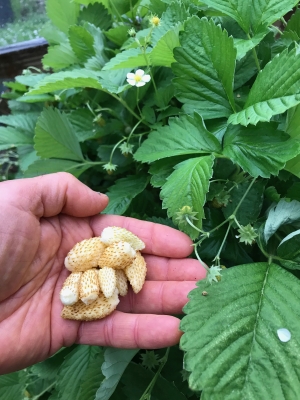
Other types of fruits have their own ways of signaling when they are ripe, and to taste at their best, they must also be harvested at just the right moment. Many people mistakenly believe that any fruit can be picked underripe, then ripened on a kitchen counter. Softening does occur, and perhaps some changes in color and sweetness, but, with few exceptions, fruit picked underripe is no match for fruit fully ripened on the plant. That softening and sweetening is more akin to incipient rot than ripening.
Pears are one of those exceptions — a fruit that must be picked mature, but not ripe. I look for a (very) subtle change in color in my pears, usually towards yellow, and easy separation from the plant if fruit is gently lifted with a slight twist. I definitively know it’s time for harvest when I see the first fruits lying on the ground. (Shakespeare knew this, writing in King Richard II: “The ripest fruit first falls.”)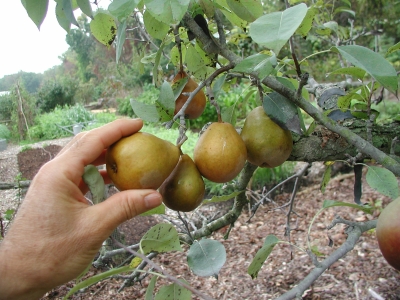
Once harvested, pears need ripening by spending a few days in a cool room Some pears, such as Anjou, Bosc, Comice, Eldorado, and Packham’s Triumph, need a few weeks in the refrigerator before they can begin their final ripening in that cool room. Care is needed; quoting Emerson, “There are only ten minutes in the life of a pear when it is perfect to eat.”
Asian pears aren’t so finicky. They’re flavor shines only if they are fully ripened on the tree.
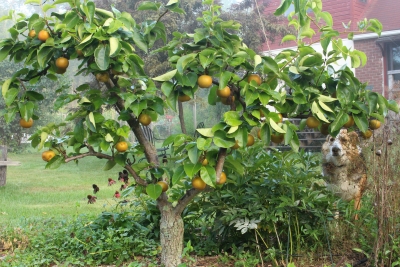
Chojuro Asian pears ready to pick
Another fruit best picked underripe is late-season apples. At harvest, Newtown Pippin, for example, is too tart for good eating. After being stored until Christmas, however, it ranks as one of the best apples. (Queen Victoria was a fan; she exempted American-grown Newtown Pippins from import tariffs.) Idared apples are hardly edible until February.
Other fruits that must be ripened off the plant are avocado and medlar. All of these fruits that are picked mature but not ripe do have to reach a certain point of maturity before they can be harvested and then ripened.
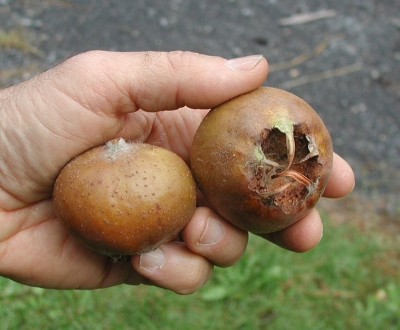
Medlar
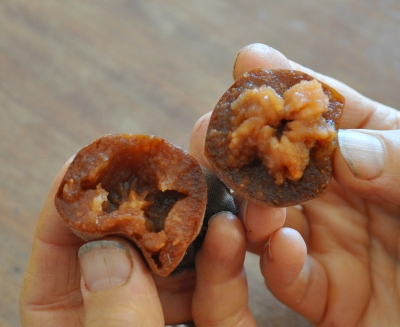
Medlar, ripened and delicious, really!
More Obvious Communiqué
The most obvious change for most fruits as optimum harvest time approaches is in color. Generally, I don’t even consider picking any fruits until they are fully colored.
Sometimes that color change can be subtle, such as my alpine strawberries that morph from icy white to creamy white. Apples and peaches broadcast their ripeness when their background color changes from green to yellow.
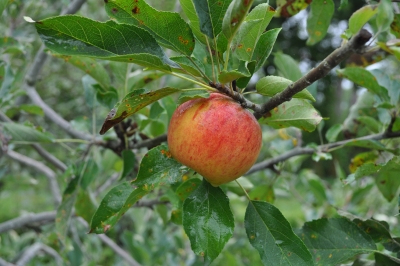
Ripe Ellison’s Orange apple
Red varieties of these fruits need direct light to color, so fruits in shade, although ripe, never turn red. And some varieties of apples have been selected for their ability to turn fully red before they are ripe.
Grapes, plums and raspberries are ready for harvest when they are fully colored; they don’t need direct light. Once the color of the fruit seems right, other indicators help me hone in on the optimum moment for harvest.
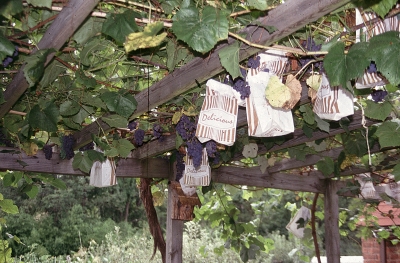
These grapes are all ripe and red, whether or not bagged
Softening is one signal; give peaches and plums a gentle squeeze. Just a look at my drooping, slightly shriveled figs tells me they are ready for picking.
As a final test for when to harvest, check how firmly a fruit is attached to the plant. In the evolutionary scheme of things, a fruit is merely a vehicle for spreading seeds, and a ripe fruit is apt to fall from the plant. Nonetheless, waiting for fruit drop is not always practical, and in some cases it does not happen until the fruit is overripe. That said, Macoun apples that I pick up each morning from beneath my tree taste better than any other Macouns I’ve ever eaten.
Test whether a plum, peach, or other large fruit is ready to separate from its tree as described above for pears: Cup the fruit in the palm of your hand, give it a slight twist around and up. If the fruit is ripe, the stem will part readily from the branch.
Similarly, fall berries, including ever-bearing raspberries, blackberries, and blueberries, readily part from plants when thoroughly ripe. To separate ripe blueberries from unripe ones, I tickle the whole bunch. Only the ripe berries drop off into my hand. Color alone is not an indicator of blueberry ripeness; another few days on the bush are needed for perfection.
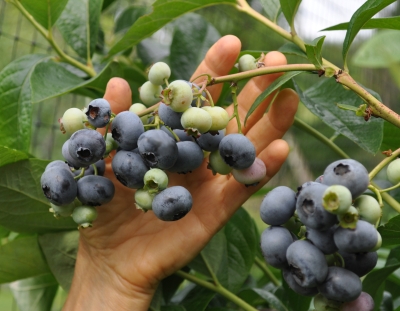
Blueberries, some ripe, some blue but not yet ripe
With fully colored grapes, whole bunches, not individual fruits, are harvested. (An exception is muscadine grapes, hardy only in the South, from which individual berries are harvested.) For truly delectable flavor, I harvest bunches of grapes when they snap cleanly and easily off the stems right where they are attached.
Final Thoughts
Don’t expect flavor to last on fruits picked ripe. Even after harvest, fruits remain alive and undergo changes. To maintain best flavor in fruits not to be eaten right away, handle them gently to avoid bruising, and maintain cool temperatures and high humidity to slow respiration (yes! fruits “breathe”) and prevent shriveling. Fruits vary widely in how long they can be stored before developing off-flavors or rot. Handle them correctly and they’ll taste good, but do not expect stored fruits, except pears and late apples, to match the flavor of those plucked fully ripe and eaten then and there.
Color, softening and ease of separation all help tell when to harvest, but the best indicator, except for fruits that need time to be stored before developing full flavor, is, of course, flavor itself. Pick an apple and take a bite or put a blackberry in your mouth; if it tastes good, you picked it at the right moment.

The final test for ripeness


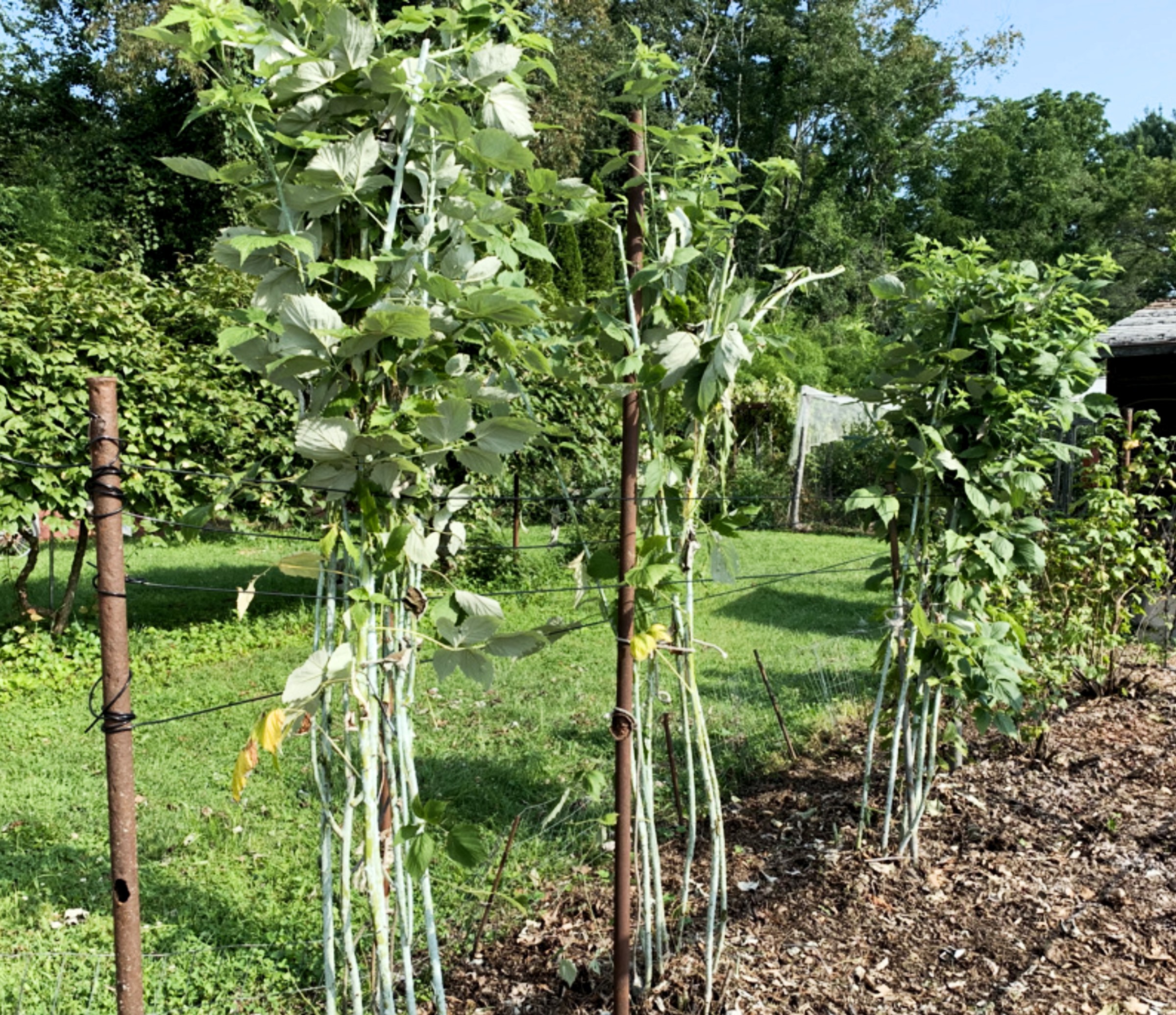

Lee, I too am growing pineberries. And that seems to be all they are doing…putting on multiple runners, lush greenery but nary a fruit has shown all summer. Granted. it is the first year for them but when can I expect to savor that ambrosia of which you speak?
Alpine strawberries, white or red, do not form runners. You could be growing Fragaria vesca, but not the alpine types. Alpine also are everbearing. It seems like you may have a different plant.
not Alpine but White pineberries…..the pineapple tasting berry with red “seeds”
The strawberries I wrote about are white alpine strawberries, Fragaria vesca. White pineberries are the same species a regular garden strawberries, Fragaria × ananassa. The flavor of the white alpine strawberries is quite different from garden strawberries and, I assume, that includes pineberries. Also their growth and bearing habit.Perhaps your pineberries need another year before they start fruiting.
thanks Lee, kind of what I figured…but why all the runners?
Some varieties of strawberries naturally make lots of runners. Junebearing varieties generally make more than everbearing or day-neutral varieties. Junebearers are the most daylength sensitive. Your pineberry is likely a junebearer that will flower and fruit next spring.
I brought 4 different types of alpine strawberry seeds and started them earlier this spring. Now I have about 25-30 plants and they are prolific and producing berries. I have Pineapple Crush, Yellow Wonder, another white one and a red one. The Pineapple Crush and Yellow Wonder were very bitter during the hot weather but the flavor has improved this fall. But it is still very better especially at the center of the fruit. I tossed out most of the summer harvest and still trying to figure out how could I improve the flavor and get rid of the bitterness at the center. I hope they will taste better next year.
Odd. I’ve grown what I originally bought as Pineapple Crush for many years. I never tasted bitterness in that variety or any of the other red or white varieties. I also save seed every year of that original Pineapple Crush. All I can say is make sure you have well-drained, reasonably fertile, adequately moist soil. I often grow them in pots with my standard potting mix.
Thanks Lee. I will try to get them water more regularly especially during the peak of the summer. I have them planted both in pots as well as on ground. Hope for better next year. Do you move your pots inside during the winter ? I recalled you had mentioned Alpine Strawberry might still be able to produce fruit indoor during the winter.
I put them in a cool, bright spot indoors, then move them to a warmer, brighter spot indoors in late winter when there’s enough light for them to start flowering again.